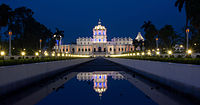Tripura Government Museum
 | |
| Established | First on 22 June 1970 and shifted new premises on 26 September 2013 |
|---|---|
| Location | Agartala, India |
| Coordinates | 23°30′04″N 91°09′57″E / 23.5010°N 91.1657°E |
The Tripura Government Museum or the Tripura State Museum, Ujjayanta Palace, Agartala in the Indian state of Tripura is housed in the Ujjayanta Palace, former royal palace of the Tripura (princely state). It was first established on 22 June 1970 as multicultural museum with emphasis on art and crafts of the state of Tripura,[1][2] and shifted to the much larger heritage edifice of the Ujjayanta Palace, opened in 1901. On 25 September 2013 a formal inauguration function was held to mark the opening of the new museum by Hamid Ansari, the Vice President of India. It is northeast India's largest museum with a "national perspective while remaining focused on Tripura and northeast India".[3]
Sandstone sculptures of the Pilak site, which represents a heterodox culture of Hinduism and Buddhism of 9th to 13th century, are on display at the Tripura Government Museum.[4]
Features
The museum had four exclusive halls when it was located in the center of the Agartala city. It was shifted to the new premises in September 2013 to the heritage palace where there are now 22 display galleries.[3][5] The exhibits in the museum are of archaeological antiquities, historical Indian sculptures, paintings and tribal culture. The museum has 1406 collections on display which include 79 stone sculptures, 141 terracotta plaques, 774 coins of gold, silver and copper, 10 copper plate inscriptions, 9 stone inscriptions, 39 images of bronze, 102 textile items, 58 Oil paintings, 63 sketches and drawings, and 197 ornaments. The sculpture collections are mostly from Udaipur, Pilak, Jolaibari, and other locations in Tripura.[1] The new museum also showcases the customs and practices of different social units of Northeast India. The objective of the museum is also to make it a "centre for active research and cultural activities".[3]
The most distinctive exhibits are from Pilak, which consist of sculptures of different cultures of Hinduism and Buddhism from the period of 9th to 13th centuries. The well crafted and molded bronze sculptures are of Mukhalinga, Avalokitesvara, Tara, and Vishnu. The terracotta exhibits are from the Pilak and Amarpur sites, and also from Bengal school; represents folk arts of Pilak and subjects related to mythology, flowers and animals, etc. There are beautiful frames of the Dasavatara carved in stone of the 18th century obtained from Radhanagar near Agartala.[1][5]
References
- ^ a b c "A Brief Description of Tripura Government Museum, Agartala, India". National Informatics Center. Retrieved 1 October 2015.
- ^ "Tripura museum to retain name of Ujjayanta Palace". Times of India. 24 September 2013. Retrieved 1 October 2015.
- ^ a b c "Museums are valuable source of history, heritage: Vice president". Zee News. 26 September 2013. Retrieved 1 October 2015.
- ^ "Tripura Govt. Museum". Tripura Government Museum. Retrieved 1 October 2015.
- ^ a b "Agartala". First Post. Retrieved 1 October 2015.


